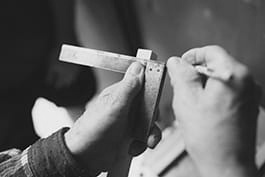Profession carpenter

Carpenters construct, erect, install, or repair structures and fixtures made of wood, wood-substitutes and other materials (e.g. metal, plastic and plasterboard).
Would you like to know what kind of career and professions suit you best? Take our free Holland code career test and find out.
Personality Type
Tasks carpenter
- Study drawings, specifications, product information, sketches or building plans to prepare the carpentry work.
- Measure distances and materials and mark cutting lines on materials using ruler, pencil, chalk, marking gauge, measuring tape, etc.
- Check existing structures using tools such as levels, framing squares, etc.
- Shape, saw or cut (building) materials (e.g. boards, timber, plywood) to specified measurements, e.g. using hand or power tools.
- Fasten (building) materials using various fastening materials, such as screws, nails, glue, bolts, etc.
- Erect scaffolding, (roof) supports, chutes, etc. to work above ground level.
- Remove damaged or defective parts or sections of structures and repair or replace these, e.g. using carpenter's hand and power tools.
- Install and repair doors, frames, timber floors, roofs, suspended ceilings, etc., e.g. using carpenter's hand and power tools.
- Finish seams and joints with lute, skirting, moulding, etc.
Related professions carpentry
- Cabinet-maker
- Carpenter helper
- CNC operator
- Concrete carpenter
- Furniture maker
- Kitchen joiner
- Maintenance carpenter
- Wood treater
Knowledge
- Woodworking tools
The various tools used to process wood, such as planers, chisels and lathes.
- Wood cuts
Different ways of cutting wood, across the grain or parallel with it, and radial or tangential to the core. The behaviour of cuts of wood under different circumstances and the optimal cut for a given purpose. Influence of special attributes of the wood, like knots or defects.
Skills
- Apply wood finishes
Use a variety of techniques to finish wood. Paint, varnish and stain wood to improve its function, durability, or appearance.
- Install wood hardware
Use hinges, knobs and rails to fix wooden hardware on wooden elements. Make sure the hardware fits onto or into the element. Make sure moving hardware articulates smoothly and securely.
- Interpret 3D plans
Interpret and understand plans and drawings in manufacturing processes which include representations in three dimensions.
- Keep track of wooden elements
Order wooden elements to be used for a workpiece in a logical way. Clearly identify the elements and how they will be joined together, using symbols drawn onto the wood or another system.
- Snap chalk line
Stretch a line covered in fine, non-staining chalk between two points and snap it against a surface to produce a straight line.
- Create smooth wood surface
Shave, plane and sand wood manually or automatically to produce a smooth surface.
- Sort waste
Manually or automatically sort waste by separating it into its different elements.
- Use safety equipment in construction
Use elements of protective clothing such as steel-tipped shoes, and gear such as protective goggles, in order to minimise risk of accidents in construction and to mitigate any injury if an accident does occur.
- Interpret 2D plans
Interpret and understand plans and drawings in manufacturing processes which include representations in two dimensions.
- Work ergonomically
Apply ergonomy principles in the organisation of the workplace while manually handling equipment and materials.
- Create wood joints
Use the proper tools and processes to create the joints where multiple pieces of wood fit together.
- Keep sawing equipment in good condition
Make sure sawing equipment is always in good and safe working condition. Inspect the equipment for defects. Replace defective or worn-out elements in accordance with guidelines. Store elements safely when not in use. Notify the responsible party in case of large or dangerous defects.
- Follow health and safety procedures in construction
Apply the relevant health and safety procedures in construction in order to prevent accidents, pollution and other risks.
- Transport construction supplies
Bring construction materials, tools and equipment to the construction site and store them properly taking various aspects into account such as the workers' safety and protection from deterioration.
- Use measurement instruments
Use different measurement instruments depending on the property to be measured. Utilise various instruments to measure length, area, volume, speed, energy, force, and others.
- Install wood elements in structures
Install elements made of wood and wood-based composite materials, such as doors, stairs, plinths, and ceiling frames. Assemble and affix the elements, taking care to prevent gaps. Inspect the work and notify the responsible person in case of problems.
- Clean wood surface
Use a variety of techniques on a wood surface to ensure it is free of dust, sawdust, grease, stains, and other contaminants.
- Join wood elements
Bind wooden materials together using a variety of techniques and materials. Determine the optimal technique to join the elements, like stapling, nail, gluing or screwing. Determine the correct work order and make the joint.
- Inspect construction supplies
Check construction supplies for damage, moisture, loss or other problems before using the material.
- Install construction profiles
Install a variety of metal or plastic profiles used to attach materials to each other or to structural elements. Cut them to size if called for.
Optional knowledge and skills
apply restoration techniques install insulation material assess conservation needs build scaffolding keep personal administration process incoming construction supplies secure working area operate table saw maintain work area cleanliness operate wood router calculate needs for construction supplies loading charts for transportation of goods follow safety procedures when working at heights monitor stock level program a cnc controller construct wood roofs order construction supplies use squaring pole work in a construction team set up temporary construction site infrastructure energy performance of buildings asbestos removal regulations keep records of work progress answer requests for quotation use sander operate band saw estimate restoration costs maintain equipment operate crosscut saw create cutting planSource: Sisyphus ODB